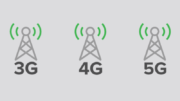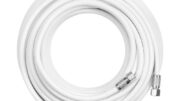This article originally ran in 2015. The rhetoric around cell towers has only gotten more intense since then, and it seemed like time to revisit it.
You might walk down the street and see one. Depending on your area, cell towers can literally be anywhere. You’ll find those white rectangular broadcast points attached to buildings, on free-standing towers, and attached to telephone poles. Of course, your parents instilled in you a very healthy fear of power lines and other stuff, and so there’s a vague worry about whether or not a cell tower can kill you. After all, it’s a commonly accepted trope that cellular radiation is somehow bad for you, even though there have been tons of studies that say the opposite.
You may be able to see a cell tower from your window, or you may even be in a building right now that has one. Should you panic?
In a word, no.
Here’s the simple reason why not: Cell towers generally have transmitters totaling between 100 and 1000 watts. The 1000 watt ones are the big tall ones so you wouldn’t be standing right next to the transmitter anyway. Now, you wouldn’t be terribly worried about standing next to a 100-watt light bulb, and while it’s not exactly the same thing, it’s close enough to the same thing that you shouldn’t get yourself all worried. Even standing next to a 1000 watt light bulb would give you a sunburn at worst.
Yeah but, I can hear you say, cell phones, put off radiation.
Radiation is evil. Radiation will cause me to grow an extra head. Radiation is the enemy. Yes, that’s true, there are some forms of radiation that are bad for you. But radiation is everywhere. (Don’t panic.) Light is radiation. Radio is radiation. The signal from your remote control is radiation. Seriously. Radiation is just a word that means an electromagnetic discharge from a thing. This includes light, infrared, heat, ultraviolet, all sorts of stuff. The worst kinds of radiation are the kinds that have a frequency higher than light. Like, ultraviolet, gamma waves, and the like. That’s the stuff that may or may not turn you into the incredible Hulk.
Cell phone radiation, along with your wi-fi, your TV reception, and other common forms of electromagnetic transmission, are on frequencies much lower than light. Seriously, all the medical evidence we have right now suggests that there is no more harm to being near to a cell tower than there is to being near a light bulb. There may be new evidence in the future, but for now, the word is that it’s just not a problem. So sleep well, even if you’re sleeping near a cell tower.
The rule of squares will protect you
There’s a concept I’ve mentioned on this blog before called “the rule of squares.” There’s a lot to it, but the basic bit is that as you double the distance from a broadcast source, the power decreases to 1/4 the original strength. What you really need to take away from this is that by the time you’re even ten feet from a cell tower, you’re getting a lot less radiation than you would get if your head was right up against it. And since those towers are often at least ten feet high, you’re always going to be safe.
When it comes to your actual phone, yes it’s going to be much closer to your body. You can use a Bluetooth device to keep the phone away from your head, but it’s still going to be somewhere near you. But, the broadcast power of your phone is something on the order of .6 – .7 watts. Even keeping it a foot away from your face is a big change. Also remember that .6 watts is less than the power from an average night light. The frequencies used by visible light are much more harmful than the relatively low frequencies used by cell phones.
Folks, the research just doesn’t support there being a problem
So far, there isn’t a lot of peer-reviewed research that shows any problem between cell phone emissions and any sort of long-term health problems. There are plenty of conspiracy theories, and it may turn out that there’s more data in the future. Right now there’s no reason to think there’s any real risk.
DISCLAIMER: No one here is a doctor. This article is based on publicly available sources and our lawyers absolutely insist we’re blameless if it turns out we’re wrong down the road.





